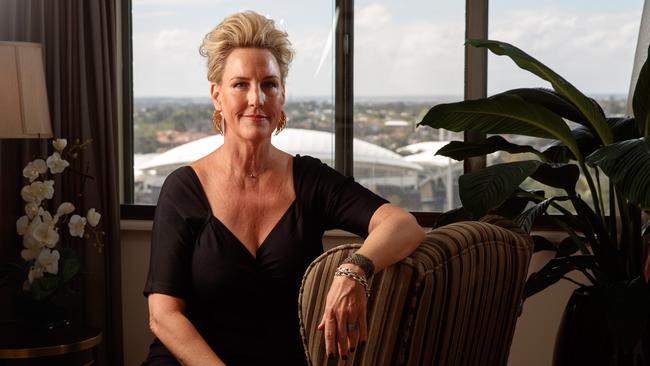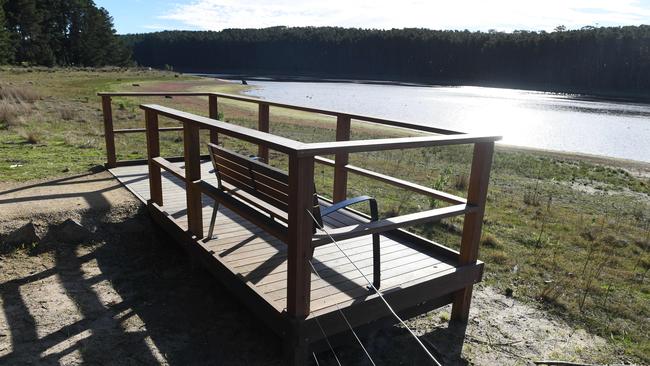Erin Brockovich backs southern Adelaide residents who say Myponga Reservoir water is making them sick
The famed campaigner has offered her tips on the “critical mistake” that has frustrated locals who say Myponga Reservoir water is making them sick.
SA News
Don't miss out on the headlines from SA News. Followed categories will be added to My News.
Famed environmental crusader Erin Brockovich has thrown her support behind residents in Adelaide’s south who say their water supply is making them sick.
The renowned environmental advocate, whose campaign on behalf of the people of Hinkley, California, inspired the Hollywood film starring Julia Roberts, described the use of chorlamine in South Australian mains water as “a critical mistake”.
It comes after some residents on the Fleurieu Peninsula this week reported they had been suffering from headaches, rashes, diarrhoea, burning eyes and itchy skin from drinking and bathing in mains water supplied from Myponga Reservoir.

However, authorities say regular testing shows the water meets the Australian Drinking Water Guidelines and is safe.
SA Water started disinfecting water piped to 3000 houses in Yankalilla, Normanville and Carrickalinga with chloramine – which is created by adding ammonia to chlorine – in March.
Prior to this, only chlorine was used.
The switch was made because the chlorine had been reacting with leaves, soil and sediment in the water, creating Trihalomethanes, which at times had exceeded the drinking water guidelines.
Local residents say they started to fall ill after changeover.
Ms Brockovich said chloramine was also used to disinfect water supplies in the US and people there had reported “rashes, burning skin, nausea, dizziness, burning eyes (and) sores on their scalps because it’s a corrosive water system”.
“We are not in favour of adding ammonia to the system at all – (SA authorities) are making a critical mistake,” she said.
Ms Brockovich called on the state government to cease using chloramine, which she said also corroded pipes, to disinfect water in SA.
“Instead of adding ammonia, you need to put on a granular activated carbon filtration system,” she said.
“(Authorities) don’t like to do that because it’s expensive so they’ve found a cheap way to cheat the system – they add ammonia to the chlorination and it’s called chloramine”.
Ms Brockovich also challenged the assertion that the water in Adelaide’s south was within the Australian Drinking Water Guidelines.
“Just because you have a guideline doesn’t mean it’s safe – it’s a guideline,” she said.
Ms Brockovich urged concerned locals to “keep going – don’t let up”.
“Continue to make phone calls, to document and take pictures of (your) skin, get on Facebook, start making other people aware … and then all of you show up,” she said.
On Friday, more residents spoke out about what they say are their adverse reactions to the mains water.
A Normanville resident, 49, who wished to remain anonymous, said he and his partner began feeling unwell shortly after the switchover occurred.
“(My partner) started getting diarrhoea and it turned yellow and she went to the doctor and they thought she had a parasite,” he said.
However, the resident said his partner underwent testing for parasites but the results came back negative.
“She stopped drinking the water and about a day or so later she was all good again,” he said.

The resident said he continued drinking the mains water and remained unwell. He said when he eventually ceased consuming the tap water, he too recovered.
“I’m drinking bottled water now – I will not drink the (mains) water,” he said.
The resident also said he experienced itchy skin when showering in the mains water.
Another local resident Pamela, who asked that her last name be withheld, said she too now only drinks bottled water after a bout of diarrhoea she says was caused by the mains water.
“It had a musty smell and taste to it,” she said.
Pamela, 70, said authorities had visited her property during the week to test her water and she was awaiting the results.
Water Minister David Speirs said Australian drinking water standards were some of the most stringent in the world and South Australians could be assured their water was safe and of high quality.
“The State Government takes its water advice from water quality and health experts, not US celebrities,” Minister Speirs said.
“Millions of Australians have their water treated in this way and to have fearmongering like this is disappointing.”

SA Water’s senior manager for water expertise and research, Dr Daniel Hoefel said the Australian Drinking Water Guidelines were mandated under the Safe Drinking Water Act and were based on “extensive scientific and medical studies”.
“The Australian Drinking Water Guidelines (2011) state the greatest risks to consumers of drinking water are pathogenic microorganisms, and with all waterborne disease outbreaks being avoidable, effective disinfection should never be jeopardised,” he said.
“Granular activated carbon is a water filtration method, already used by SA Water, not a disinfectant process and wherever it is used, a disinfectant is still required to deactivate pathogens and protect drinking water customers.”
SA Health principal water quality adviser Dr David Cunliffe said chloramine was extensively used in Australia and overseas to disinfect water.
“Chloramines have been used to disinfect drinking water supplies in South Australia since the early-1980s and is used successfully to maintain safe drinking water for 220,000 South Australians,” he said.
“Similarly to chlorinated water, a limited number of individuals may experience skin irritation from chloraminated water and anyone with concerns should always seek medical advice from their GP or healthcare provider.”
Ms Brockovich, who is an ambassador for Australian law firm Shine Lawyers, has also been an advocate for communities affected by PFAS contamination on and around Australian RAAF bases.




